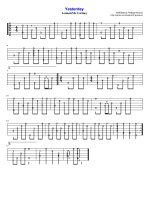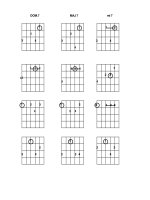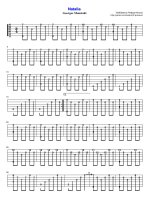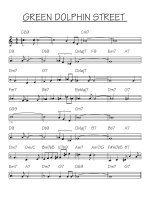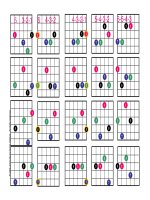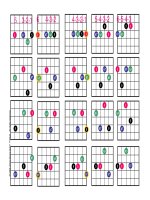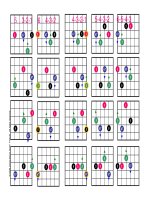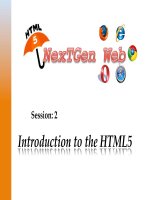HTML5 XP session 16 tủ tài liệu bách khoa
Bạn đang xem bản rút gọn của tài liệu. Xem và tải ngay bản đầy đủ của tài liệu tại đây (11.14 MB, 56 trang )
Session: 16
Building a Mobile Web
Application
the
features
of
different
mobile
devices
Describe
List
the
different
types
of
plaDorms
available
for
mobile
devices
the
design
and
architectural
aspects
of
a
mobile
Web
site
Explain
Explain
the
requirements
for
developing
and
tes4ng
of
a
mobile
Web
site
HTML5
support
for
a
mobile
Web
site
Explain
List
the
best
prac4ces
for
op4mizing
a
mobile
Web
site
©
Aptech
Ltd.
Building
a
Mobile
Web
Applica4on
/
Session
16
2
access
to
the
Web
is
not
limited
to
only
desktop
systems,
but
is
also
Today,
available
on
portable
and
wireless
devices,
such
as
mobiles
devices.
A mobile device, also known as a handheld device, is a small portable computing device
with a small display screen and keyboard.
A mobile device has an operating system on which various types of application software
are executed.
These application software are also known as apps.
The most commonly used apps are mobile browsers that display the Web pages.
©
Aptech
Ltd.
Building
a
Mobile
Web
Applica4on
/
Session
16
3
The
different
categories
of
mobile
phones
available
in
the
market
are
as
follows:
Ø Basic Mobile Devices
basic
models
with
only
call
and
Short
Message
Service
(SMS)
facility.
Very
Do
not
provide
support
for
Web
browsers
or
network
access.
Ø Low-end Mobile Devices
more
features
than
a
basic
mobile
device,
typically
Web
support
Provide
by
users
who
do
not
need
heavy
Internet
usage.
Preferred
a
basic
camera
and
a
basic
music
player.
Include
such
as
Nokia,
Motorola,
Sony
Ericsson,
Samsung,
and
so
forth
Manufacturers,
have
gained
popularity
for
offering
low
cost
handsets
in
the
global
market.
©
Aptech
Ltd.
Building
a
Mobile
Web
Applica4on
/
Session
16
4
figure
shows
the
low-‐end
mobile
devices
available
from
different
Following
manufacturers.
Ø Mid-end Mobile Devices
types
of
mobile
devices
have
gained
popularity
due
to
their
increased
user
These
experience
and
moderate
cost.
key
features
of
these
devices
include:
medium
sized-‐screen,
HTML
supported
Some
browser,
a
decent
camera,
games,
and
support
for
applica4ons.
have
a
proprietary
Opera4ng
System
(OS)
that
is
not
well-‐known
and
is
also
They
not
portable
across
various
plaDorms.
Building
a
Mobile
Web
Applica4on
/
Session
16
©
Aptech
Ltd.
5
figure
shows
the
mid-‐end
mobile
devices
available
from
different
Following
manufacturers.
Ø High-end Mobile Devices
types
of
mobile
devices
have
advanced
features,
such
as
an
accelerometer,
These
advanced
camera
features,
and
Bluetooth.
They
have
a
be]er
look
and
feel
as
compared
to
mid-‐end
mobile
devices.
©
Aptech
Ltd.
Building
a
Mobile
Web
Applica4on
/
Session
16
6
Following
figure
shows
the
high-‐end
mobile
devices.
Ø Smartphones
are
mobile
devices
with
mul4tasking
capabili4es.
These
devices
have
a
full
browser
support
similar
to
desktop
browsers
with
These
wireless
LAN
and
3G
connec4on.
©
Aptech
Ltd.
Building
a
Mobile
Web
Applica4on
/
Session
16
7
They
have
several
advanced
features
that
are
as
follows:
Compass
Digital
Posi4oning
System
(GPS)
Global
screen
Touch
with
video
recording
Camera
out
TV
Bluetooth
Accelerometer
Following
figure
shows
the
various
smartphone
devices.
©
Aptech
Ltd.
Building
a
Mobile
Web
Applica4on
/
Session
16
8
Ø Tablets and Notebooks
devices
are
larger
than
mobile
phones.
These
are
mobile
computers
with
a
touch
screen
virtual
keyboard
and
stylus
or
They
digital
pen.
of
tablets
include:
mul4-‐touch
display,
be]er
user
experience,
high
Features
quality
screen
resolu4on,
be]er
Web
support,
and
mul4tasking
OS
with
high
speed.
of
the
tablets
available
in
the
market
are
BlackBerry
PlayBook
Tablet
PC,
Some
Samsung
Galaxy
Tab,
and
HCL
Me
Tab.
Following
figure
shows
different
types
of
tablet
devices.
©
Aptech
Ltd.
Building
a
Mobile
Web
Applica4on
/
Session
16
9
A mobile device platform is similar to a software platform.
It is basically responsible to interact with the device hardware and run software/services
on the mobile device.
The mobile platforms are categorized as proprietary and open source.
Proprietary platforms are those which are designed and developed by the mobile device
manufacturers.
These platforms are developed for specific devices and are not supported on all
platforms.
Open source platforms are those which are freely available to the users.
The users can download the source code and alter them as per their requirements.
©
Aptech
Ltd.
Building
a
Mobile
Web
Applica4on
/
Session
16
10
The
brief
descrip4on
of
the
plaDorms
available
on
mobile
devices
is
as
follows:
Palm OS
• It is a proprietary mobile OS developed by Palm Inc. and was used for Personal Digital
Assistants (PDAs).
• Currently, Palm Inc. has developed webOS, which is based on the Linux kernel.
Blackberry OS
• It is a proprietary mobile OS developed by Research in Motion (RIM) and is based on
Java platform.
• It is primarily used by Blackberry smartphone devices.
iOS
• It is a mobile OS developed by Apple Inc. and was initially referred to as iPhone OS.
• It is derived from Mac OS X, which is based on the UNIX platform.
Symbian
• It is an open source mobile OS developed for mobile phones.
• It includes a user interface framework, libraries, and component tools.
©
Aptech
Ltd.
Building
a
Mobile
Web
Applica4on
/
Session
16
11
Windows Mobile
• It is a mobile OS that runs on top of the Windows Mobile platform.
Linux
• It is an open source OS and is supported by smartphones that are manufactured by
Motorola.
Android
• Android is an open source OS developed by Google. It is currently used by smartphones
and tablet computers.
• It is a mobile OS developed by Apple Inc. and was initially referred to as iPhone OS.
©
Aptech
Ltd.
Building
a
Mobile
Web
Applica4on
/
Session
16
12
of
the
basic
considera4ons
needed
for
designing
a
Web
sites
for
intended
Some
mobile
device
are
as
follows:
and
Physical
Dimension
Resolu4on
Orienta4on
Page
Input
methods
Ø Resolution and Physical Dimension
resolu4on
means
the
number
of
pixels
(width
and
height)
on
the
screen
of
the
The
mobile
device.
Following
table
lists
the
resolu4ons
of
mobile
devices
based
on
their
categories.
Category
Resolutions (in pixels)
Low-end mobile devices
128 x 160 or 128 x 128
Mid-end mobile devices
176 x 220 or 176 x 208
High-end devices
240 x 320
Smartphones
240 x 480, 480 × 320, 640 × 480, or 960 × 640
©
Aptech
Ltd.
Building
a
Mobile
Web
Applica4on
/
Session
16
13
The resolution of mobile devices is measured in terms of the physical dimensions of the
screen.
The screen dimensions are either measured diagonally in terms of inches/centimeters or
in terms of width and height.
The relation between the physical dimension and resolution is termed as Pixels per Inch
(PPI) or Dots per Inch (DPI).
The higher DPI results in good print-quality graphics on the mobile device.
©
Aptech
Ltd.
Building
a
Mobile
Web
Applica4on
/
Session
16
14
Following
table
lists
the
resolu4on
and
display
sizes
of
different
mobile
devices.
Manufacturer
Model
Screen
Size
Resolution (in
pixels)
Type
Apple
iPad3
9.7”
2048×1536
Apple
iPhone 3GS
3.5”
480×320
Smartphone
Apple
iPhone 4S
3.5”
960×640
Smartphone
Blackberry
Torch 9810
3.2”
640×480
Smartphone
HP
Touchpad
9.7”
768×1024
Tablet
Samsung
Galaxy S 4G
4”
480×800
Smartphone
Samsung
Galaxy S II
4.52”
800×480
Smartphone
Nokia
Lumia 800
3.7”
480x800
Smartphone
©
Aptech
Ltd.
Tablet
Building
a
Mobile
Web
Applica4on
/
Session
16
15
Ø Page Orientation
mobile
devices
are
also
categorized
based
on
their
orienta4on,
ver4cal
and
The
horizontal.
ver4cal
orienta4on
devices
are
also
referred
to
as
portrait
devices
with
taller
The
display.
the
horizontal
orienta4on
devices
are
referred
as
landscape
devices
with
Similarly,
wider
display.
Following
figure
shows
the
mobile
devices
with
ver4cal
and
horizontal
screens.
©
Aptech
Ltd.
Building
a
Mobile
Web
Applica4on
/
Session
16
16
Smartphones and tablets can switch between landscape and portrait views to present the
better viewing of a Web page.
This rotation capability of changing the view from landscape to portrait or vice-versa is
due to the hardware accelerators available in the phones.
A mobile Web site must be aware of these rotations and should provide a good user
experience in both the orientations.
Ø Input Methods
Some
of
the
possible
input
methods
for
a
mobile
device
are
as
follows:
keypad
Numeric
keypad
(Simple
or
QWERTY)
Alphanumeric
keypad
on
screen
Virtual
Mul4-‐touch
keypad
External
Voice
and
handwri4ng
recogni4on
©
Aptech
Ltd.
Building
a
Mobile
Web
Applica4on
/
Session
16
17
Following
figure
shows
a
mobile
device
with
QWERTY
keyboard
and
touch
screen.
©
Aptech
Ltd.
Building
a
Mobile
Web
Applica4on
/
Session
16
18
Web
site
developed
for
a
mobile
device
is
a
collec4on
of
Web
pages.
The
it
is
essen4al
to
understand
a
few
architectural
concepts
that
can
help
to
Thus,
create
meaningful
mobile
services.
Some
of
the
concepts
that
relate
to
its
architecture
are
as
follows:
Ø Navigation
is
the
path
followed
by
a
user
to
travel
in
a
Web
site.
Naviga4on
compared
to
the
naviga4on
tree
of
a
desktop
site,
almost
80%
of
the
As
informa4on
of
a
desktop
site
will
not
be
useful
to
a
mobile
Web
site.
Thus,
the
main
focus
should
be
on
20%.
Design
Web
pages
based
on
the
use
cases.
Arrange
Web
pages
depending
on
the
frequent
requirements
of
the
mobile
users.
Restrict
the
depth
of
a
mobile
page
to
three
clicks
for
a
specific
use
case.
©
Aptech
Ltd.
Building
a
Mobile
Web
Applica4on
/
Session
16
19
Design
minimum
input
controls
for
the
form
pages.
Desktop
Web
site
normally
has
a
welcome
screen.
In
case
of
mobile
Web
sites,
avoid
developing
welcome
screens.
While
designing
a
service,
decide
its
usability.
Approximate
the
number
of
mobile
pages
required
to
separate
services,
aher
the
home
page.
Ø Perspective
perspec4ve
of
a
mobile
user
is
different
from
a
desktop
user
in
terms
of
needs
The
and
accessibility.
a
user-‐centric
design
approach
should
be
followed
for
designing
mobile
Hence,
Web
sites.
This
ensures
that
a
user
completes
the
task
easily
and
successfully.
©
Aptech
Ltd.
Building
a
Mobile
Web
Applica4on
/
Session
16
20
Some of the possible users’ contexts are as follows:
What
is
the
loca4on
of
the
user?
Why
is
a
mobile
Web
site
accessed
by
the
user?
What
are
the
needs
of
the
user?
What
solu4on
is
offered
by
a
mobile
applica4on
to
solve
the
user’s
problem?
Where
is
the
user
present
while
accessing
a
Web
site?
Ø Enhancement
is
a
simple
and
powerful
technique
that
can
be
adopted
while
Enhancement
designing
a
mobile
Web
site.
technique
defines
compa4bility
of
Web
site
and
allows
access
to
basic
This
content,
services,
and
func4onality
on
all
type
of
mobile
devices.
Also,
it
provides
a
be]er
Web
experience
on
devices
with
higher
standards.
©
Aptech
Ltd.
Building
a
Mobile
Web
Applica4on
/
Session
16
21
Some of the core principles for enhancing mobile Web sites are as follows:
Basic
content
and
func4onality
are
accessible
in
all
browsers.
Enhanced
layout
and
behavior
must
be
provided
through
external
style
sheets
and
JavaScript
that
are
linked
with
the
Web
pages.
Markup
elements
used
on
the
pages
must
have
proper
seman4c.
Web
browser
selngs
on
a
user’s
device
should
be
considered.
Ø Use of Web Standards
Web
standards,
such
as
HTML,
CSS,
and
JavaScript
followed
in
the
mobile
The
Web
site
design
must
be
correctly
used.
increases
the
possibility
of
displaying
pages
on
large
number
of
devices.
This
well-‐formedness
of
the
markup
tags
used
on
a
page
can
be
achieved
by
The
valida4ng
them.
the
use
of
certain
HTML
elements
can
be
avoided
while
designing
the
Web
Also,
pages
for
mobile
devices.
©
Aptech
Ltd.
Building
a
Mobile
Web
Applica4on
/
Session
16
22
The
brief
descrip4on
of
these
elements
is
as
follows:
Use of HTML tables
• As the screen size of mobile devices is small, so the use of tables in layouts should be
avoided.
• It makes the scrolling difficult and also slows down the page loading in the browser.
Pop-up windows
• The Web sites with pop-up windows makes the site impractical to work with.
• Also, all mobile browsers do not provide support for them.
Use of graphics
• The use of graphics increases download time of the pages.
• Also, they can obstruct the layout of the old mobile browsers, resulting in incorrect
display of the page.
Use of frames
• Many mobile devices do not provide the support for frames due to usability problems.
• Also, the HTML5 new specification does not provide the support for frames.
©
Aptech
Ltd.
Building
a
Mobile
Web
Applica4on
/
Session
16
23
Web
applica4ons
are
developed
to
be
run
on
different
mobile
devices.
Mobile
they
need
to
be
tested
in
several
different
environments.
Hence,
tools
required
to
develop
a
mobile
Web
applica4on
are
namely,
The
Integrated
Development
Environment
(IDE)
and
emulators.
These
are
described
as
follows:
Ø IDE
IDE
is
a
tool
used
for
coding
the
markup,
JavaScript,
and
CSS.
An
Some
of
these
tools
are
as
follows:
Dreamweaver
Adobe
Expression
Web
Microsoh
Studio
Aptana
Eclipse
Editplus
(text
editor)
versions
of
these
tools
provide
be]er
support
for
mobile
markups.
Latest
They
also
provide
support
for
valida4ng
pages
against
mobile
Web
standards.
©
Aptech
Ltd.
Building
a
Mobile
Web
Applica4on
/
Session
16
24
Ø Emulators
emulator
is
a
sohware
that
translates
the
compiled
code
to
the
na4ve
An
plaDorm
on
which
the
applica4on
is
executed.
emulator
runs
as
a
desktop
applica4on
that
allows
tes4ng
and
debugging
The
of
a
mobile
applica4on.
offers
the
environment
similar
to
a
real
mobile
device
on
which
an
It
applica4on
will
be
executed.
are
developed
by
manufacturers
and
are
ohen
offered
free
to
Emulators
users.
are
either
standalone
applica4ons
or
bundled
with
a
Sohware
They
Development
Kit
(SDK)
for
na4ve
development.
Some
of
the
popular
emulators
are
as
follows:
Android
iOS
webOS
Blackberry
Phone
Windows
Opera
Mobile
©
Aptech
Ltd.
Building
a
Mobile
Web
Applica4on
/
Session
16
25


